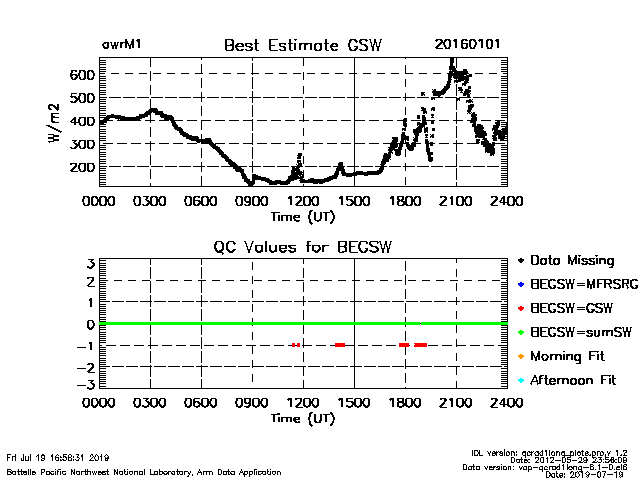New Radiation Data Quality (QCRAD) VAP Release Available for AWARE Field Campaign
Published: 23 September 2019

The Data Quality Assessment for ARM Radiation Data (QCRAD) value-added product (VAP) is now available for the ARM West Antarctic Radiation Experiment (AWARE) field campaign.
QCRAD has long been ARM’s recommended datastream for broadband surface irradiance measurements. The QCRAD methodology uses climatological analyses of the surface radiation measurements to define reasonable limits for testing the data for unusual values. QCRAD applies multiple data quality checks, corrects for errors due to infrared loss in shortwave (SW) radiometric measurements, and calculates a best-estimate total downwelling SW irradiance value.
Data are processed for the full length of the AWARE deployment at McMurdo Station (M1) and the supplemental site on the West Antarctic Ice Sheet (S1). Available QCRAD datastreams and date ranges for AWARE are:
- c2—20151124.000000 to 20170102.000000
- s2—20151124.000000 to 20170102.000000
- c1—20151205.000000 to 20160119.000000
- s1—20151205.000000 to 20160119.000000.
The QCRAD VAP produces two daily files containing 1-minute radiation measurement fields and their quality control (QC) values. The *.c1 file—the asterisk represents the datastream name—includes auxiliary information and detailed qc flags. The *.s1 summary file includes a simplified version of the qc flags and fewer auxiliary data values.
The .c1 data are created using a generic correction to the downwelling SW hemispheric flux to correct for infrared loss within the radiometer. The .c2 coefficients use infrared loss corrections derived for the specific instruments rather than the generic correction. This correction will affect the output of the downwelling SW values when the sum of the direct plus diffuse SW is not available as the best estimate for downwelling SW.
M1 datastreams for AWARE are available at the .c2/.s2 level. S1 data will only be available at the .c1/.s1 level because that portion of the deployment did not have any nighttime periods, so instrument-specific infrared loss correction coefficients cannot be generated (Dutton et al. 2001; Younkin and Long 2003).
Scientists can use the new QCRAD data now. To share your experience—such as how you use the data and how well it works for you—or to ask a question, contact Josh Howie.
More information on QCRAD is available on the VAP web page. To access these data, go to the ARM Data Center. (Go here to request an account.)
To cite the QCRAD data, please use doi:10.5439/1027372.
References: Dutton EG, JJ Michalsky, T Stoffel, BW Forgan, J Hickey, DW Nelson, TL Alberta, and I Reda. 2001. “Measurement of Broadband Diffuse Solar Irradiance Using Current Commercial Instrumentation with a Correction for Thermal Offset Errors.” Journal of Atmospheric and Oceanic Technology, 18(3), 10.1175/1520-0426(2001)018<0297:mobdsi>2.0.co;2.
Younkin K and C Long. 2003. “Improved Correction of IR Loss in Diffuse Shortwave Measurements: An ARM Value-Added Product.” U.S. Department of Energy. ARM/TR-009.
Keep up with the Atmospheric Observer
Updates on ARM news, events, and opportunities delivered to your inbox
ARM User Profile
ARM welcomes users from all institutions and nations. A free ARM user account is needed to access ARM data.


















